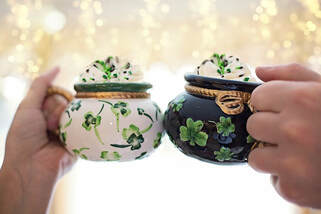
During March you hear lots of Irish music and see Celtic Knot designs and cartoon leprechauns. Besides that, in these final days of winter, you may be reminded of the legendary pot of gold at the end of the rainbow. Since the icons of this holiday include imaginary little people and 4-leaf clovers, which occur with a frequency of 5000 to 1 compared to the 3-leaf variety, lets add our own bit of scientific blarney in the form of optical illusions. This is the science of reflection.
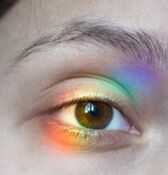
But, before learning about reflection, it’s important to understand that what we see is the result of the interaction between light, our eyes, and brain. When light hits our eyes, special cells called photoreceptors turn the light into electrical signals. These electrical signals travel to our brains, which make sense from them. Without light, there would be no sight.

Light interacts with surfaces in three ways. If light hits a transparent object, it passes through it; If light hits an opaque object, it sinks into it; If light hits a reflective object, it bounces back. Light is a form of energy. Conservation of Energy
Conservation of energy is a scientific law which states that energy cannot be created or destroyed. It can only be converted to a different form. For example, when you switch on an electric lamp, the light comes from electricity flowing from a power plant. That power plant got the electricity by extracting energy from a source, such as oil or coal. The energy in oil and coal came from the sun, which gets its energy from nuclear reactions happening deep inside its core. Energy must always come from somewhere and go somewhere else. 
What you see when you look in the mirror is also an example of conservation of energy. When light energy hits an object, that energy must go somewhere. Conservation of energy is always happening. Sometimes energy gets converted into other forms. Mirrors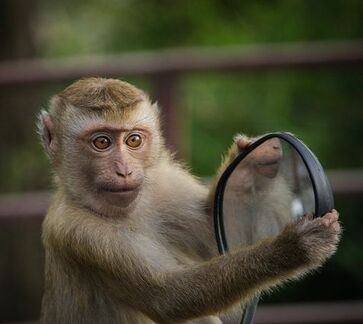
All objects absorb, reflect, and transmit the light falling on them, depending on the materials they're made from. Things we call "mirrors" are a special class of objects that reflect an unusual amount of that light. When you look in a flat mirror, rays of light (photons) shoot through the glass and hit the coating behind it. Light reflects off the mirror in an orderly way called specular reflection. The type of image produced by a flat mirror is called a virtual image. Even though light is bouncing off the mirror, our eyes are fooled into thinking it's coming out of the mirror in a straight line. Of course, you should know that when you see yourself in a flat mirror, you are not actually standing in front of yourself. You are seeing your virtual self! How’s that for a bit of scientific blarney?
Types of Mirrors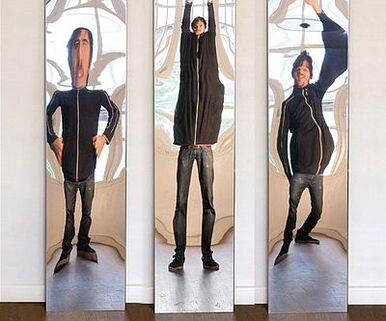
There are several types of mirrors. The types you commonly see are plane, concave, and convex.
• Plane mirrors are flat. What you see in the glass is a reasonable approximation to what's there, but the image appears to be shifted from left to right (laterally inverted). • Concave mirrors bow inward at the center. From far away, objects in concave mirrors seem upside down, but as you get closer and pass the focal point, the image flips and magnifies. Up close, reflections appear nearer to you and bigger than they are. • Convex mirrors bulge outward at the center. Reflections appear smaller and further away than they are. The back of a spoon and driving mirrors are convex. Some department stores have reportedly placed convex mirrors in their dressing rooms because slight bends at the top and bottom make you look taller and thinner. If you look great in the clothes, maybe you’ll buy them! • Two-way mirrors: These mirrors are made by coating one side of a sheet of glass with a very thin, very lightly reflective material. When the coated side faces a lighted room, some of the light reflects and some goes into a dark room behind the mirror, making it possible to see into the lighted room but not out. (These are used for police interrogation rooms.) Classroom investigation: HaVE STUDENTS Make a 4-leaf clover with a green dot & 2 mirrors
Students will need: Paper, 2 small mirrors, colored pencils, props to hold up mirrors, and a protractor.
Watch the tiktok example below, then read on for the full instructions!
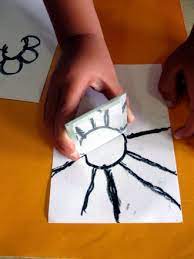
Have your students draw a green circle on an index card. Have them prop the two mirrors at an angle and see if they can reflect two circles, then four circles, and then try to make the reflection look like a four-leaf clover. Have them keep adjusting the angle and placement of the mirrors.
They can also experiment with drawing rainbows and symmetrical shapes or letters to see how many designs they can make using the mirrors. They can photograph their reflections to document what they've discovered. Help students to analyze their findings
Ask them what was the greatest number of leaves that they made on the clover. Have them measure the different angles of the mirrors with a protractor and compare that to the number of leaves it creates on the clover. Discuss any patterns they found with their rainbow and other symmetrical shapes.
Here is an organized lesson plan for this activity.
0 Comments
Leave a Reply. |
AuthorGertrude Katz has spent over 30 years teaching K-12 public school students all major subjects. She has taught biology and education at the college level. The majority of her career has been spent instructing biology at the secondary level. Categories
All
|
 RSS Feed
RSS Feed